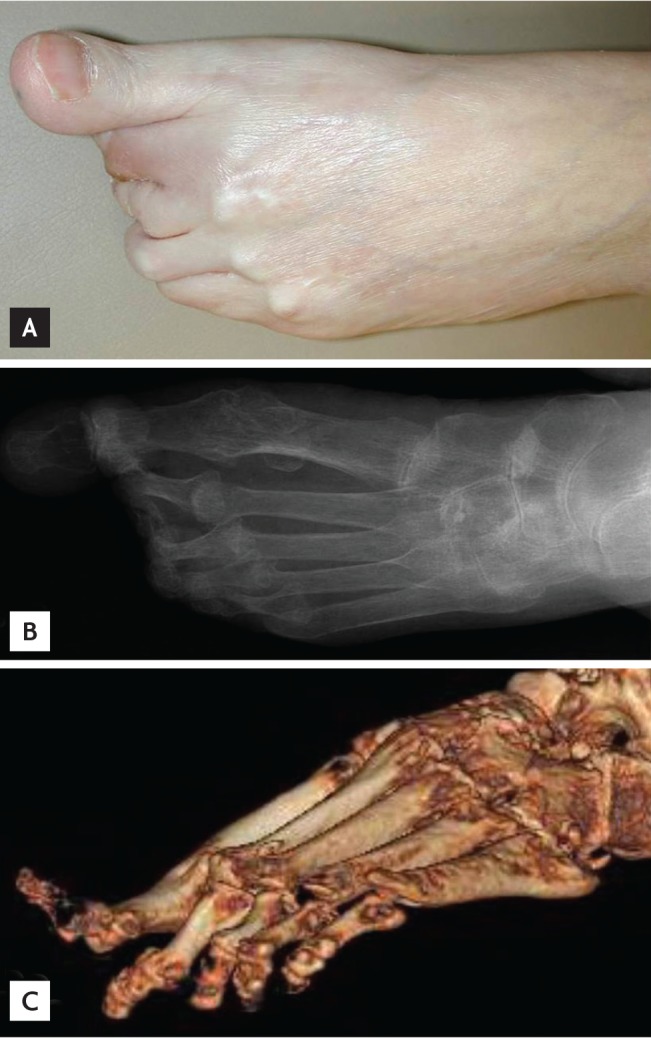 |
 |
| Korean J Intern Med > Volume 29(3); 2014 > Article |
|
To the Editor,
The foot is involved in 80% to 90% of rheumatoid arthritis (RA) patients and the forefoot is affected the most [1]. Disruption of the ligaments, capsule, and other periarticular structures resulting from synovitis frequently leads to foot deformities. Common forefoot deformities in RA are hallux valgus, dislocation of the metatarsophalangeal (MTP) joints of the lesser toes, and claw toe [1,2]. The typical MTP joint deformity of the lesser toes in RA is dorsal dislocation of the proximal phalanges on the metatarsal heads and subsequent plantar displacement of the metatarsal heads with resultant plantar callosities. Recently, we experienced an unusual MTP joint deformity in a recurring rheumatoid foot in which the metatarsal heads were displaced dorsally and led to the dorsal protrusion of the MTP joints and subsequent dorsal callosities.
A 76-year-old woman with a 25-year history of seropositive RA presented with painful deformities of both feet. Nine years earlier, she had undergone arthrodesis of the first MTP joints and resection arthroplasty of the MTP joints of all of the lesser toes of both feet. Four years later, bilateral knee replacement surgery was performed. The physical examination of the left foot revealed hyperextension of the first interphalangeal joint and claw toe deformities of the lesser toes (Fig. 1A). Of note, the MTP joints of the third to fifth toes protruded dorsally with dorsal callosities, which is an unusual MTP joint deformity in a rheumatoid foot. The plain X-ray of the left foot showed subluxation of the second to fifth MTP joints and erosions and diffuse joint space narrowing involving nearly all of the foot joints (Fig. 1B). Three-dimensional computed tomography showed dorsal subluxation of the metatarsal heads on the proximal phalanges of all the lesser toes (Fig. 1C), which seemed to have caused the dorsal protrusion of the MTP joints. Hyperextension of the first interphalangeal joint and claw toe deformities of the lesser toes were also apparent. To correct the foot deformities, fusion of the first interphalangeal joint and resection arthroplasty of the second to fifth MTP joints were performed.
Rheumatoid forefoot deformities begin with hallux valgus, which makes the first toe incapable of weight bearing and leads to greater loads through the lesser toes [1,2]. This results in the dorsal subluxation of the proximal phalanges of the lesser toes and flexion deformity at the proximal interphalangeal joint, which is called claw toe when accompanied by a flexion deformity at the distal interphalangeal joint. As the dorsally dislocated phalanges push the corresponding metatarsal heads so that they are plantar flexed, plantar displacement of the metatarsal heads develops with resultant plantar callosities. Our case is unique in that the metatarsal heads were displaced dorsally and led to dorsal protrusion of the MTP joints with subsequent dorsal callosities, which is a very unusual form of MTP joint deformity in rheumatoid foot.
The MTP joint deformity of the lesser toes is usually corrected with resection arthroplasty or shortening of the metatarsal heads in combination with arthrodesis of the first MTP joint [1,2,3,4]. Recurrence of the MTP joint deformity is common and causes metatarsalsia and plantar callosities again [1,3]. In our case, the MTP joint deformities recurred with dorsal displacement of the metatarsal heads, which differed from the original deformity. It appears that the distal metatarsal heads remaining after the initial surgery were too sharp, with their apices located dorsally (Fig. 1C), which might have caused the proximal phalanges to displace downwardly along the cut surface of the metatarsal heads, pushing the metatarsal heads dorsally because the MTP joints are usually mobile after a resection arthroplasty. Overcorrection or malposition of the reduced MTP joints, and flexor-extensor tendon imbalance after the initial operation are other explanations for this unusual MTP joint deformity. The hyperextension of the first interphalangeal joint was also unusual. Our case shows that when deformities recur in a previously operated foot in RA, they can differ from the original deformity.
References
1. Amin A, Cullen N, Singh D. Rheumatoid forefoot reconstruction. Acta Orthop Belg 2010;76:289–297PMID : 20698446.


2. Jeng C, Campbell J. Current concepts review: the rheumatoid forefoot. Foot Ankle Int 2008;29:959–968PMID : 18778679.


Figure 1
(A) Gross appearance of the lef t foot shows hyperextension of the first toe, claw toe deformities of the lesser toes, and dorsal protrusion of the third to fifth metatarsophalangeal (MTP) joints with dorsal callosities. (B) Plain radiograph of the left foot shows subluxation of the second to fifth MTP joints and erosions and diffuse joint space narrowing involving nearly all of the foot joints. (C) Three-dimensional computed tomography of the left foot shows hyperextension of the first interphalangeal joint, claw toe deformities, and dorsal subluxation of the metatarsal heads on the proximal phalanges of all the lesser toes.




 PDF Links
PDF Links PubReader
PubReader ePub Link
ePub Link Full text via DOI
Full text via DOI Download Citation
Download Citation Print
Print



